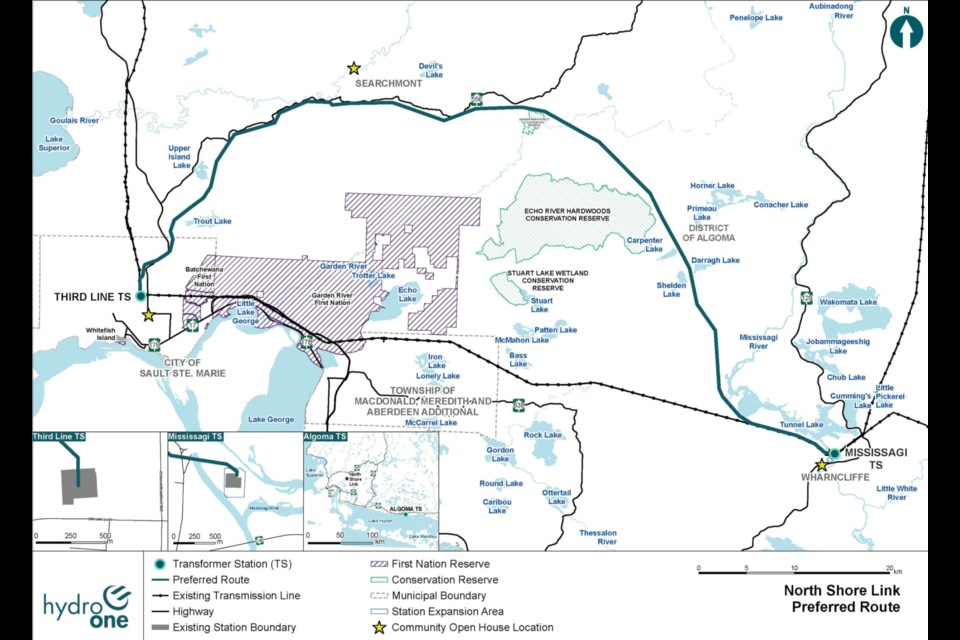A consortium of eight First Nations working with Hydro One on major transmission line projects wants to set the benchmark for how similar partnerships are struck in the region.
Waasmoowin Energy Inc. has been at the table with Hydro One Networks Inc. since last year, working towards the development of the North Shore Link and Northeast Power Line projects, which aim to bolster infrastructure from Sault Ste. Marie to Sudbury in an effort to support growing electricity demands in the North.
Waasmoowin recently announced the launch of a not-for-profit company and a pair of limited partnerships that will advance work on the projects, which are operating under a 50-50 equity partnership model originally pitched by Hydro One in the spirit of reconciliation.
“It's been a long time coming,” said Mississauga First Nation Chief Brent Niganobe, who serves as president and chair for the Waasmoowin board of directors.
“We've obviously made this corporation to move the project ahead. We have the support of all eight First Nations, so it's very exciting.”
The newly established Waasmoowin Opportunities and Consultation Council will serve as the main point of engagement to ensure environmental issues and treaty rights are considered.
The council will also negotiate project benefits such as employment and contracting opportunities for participating First Nations.
Waasmoowin NSL LP and Waasmoowin NEPL LP, meanwhile, have been established to hold the equity for both transmission projects.
Once complete, the Northeast Power Line will connect Hydro One’s Hanmer Transformer Station in Greater Sudbury and the Mississagi Transformer Station near Wharncliffe with a 500-kilovolt transmission line.
There's also the North Shore Link, which will establish a new, double-circuit 230-kilovolt line between Mississagi Transformer Station and Third Line Transformer Station in Sault Ste. Marie.
It’s anticipated that construction of both transmission lines will begin in 2027 and will be completed some time in 2029.
Niganobe says the pair of powerline projects represent the type of agreements that chiefs in the area have been advocating for — agreements that reflect “real, actual and true partnership.”
The Waasmoowin chair now wants to see its partnership with Hydro One be considered as the “gold standard” for Indigenous communities going forward, as First Nations leadership didn’t have “much of a say” when it came to impact benefit agreements for major infrastructure projects in the past.
“You would get something annually, but it wouldn't be anything to this extent of what we're seeing,” Niganobe said.
“I think a lot of projects just came in and promised things — without agreements — and obviously, we didn't see the fruition of some of those.
“We would be left with something that may have lasting effects on us — on our land — but we wouldn't see any kind of benefit from it. That's not what we envisioned with treaties, or with partners.”
Niganobe believes the North Shore Link project will have some trickle-down benefits for all eight First Nations along the north shore, whether it’s in the form of economic spinoffs for businesses or jobs for band members.
On a broader level, there are hopes the projects bring long-term benefits that lead to generational wealth for the communities involved.
“The timeline is there for us to be a part of it sooner rather than later,” Niganobe said.
“I think down the road it's going to be contracts, funds going back into the community and good jobs for community members.”
Last month, SooToday's Kenneth Armstrong revealed that Garden River First Nation — which had originally spearheaded the First Nations consortium — backed out of Waasmoowin after Chief Karen Bell became dissatisfied with other members of the consortium outvoting GRFN on key decisions.
A portion of the preferred path for the transmission lines also crosses over an area that is part of an active Garden River land claim with the government.
“This isn't hypothetical — it’s before the courts. We are seeking the return of that land. If it’s used now, it’s lost to our people forever,” Bell said at the time.
The remaining agreements that need to be signed in order for the powerline projects to advance are covered through non-disclosure agreements that were signed between the two parties.
Waasmoowin Energy Inc. is owned by eight First Nations — Atikameksheng Anishnawbek, Batchewana First Nation, Mississaugi First Nation, Sagamok Anishnawbek, Serpent River First Nation, Thessalon First Nation, Wahnapitae First Nation, and Whitefish River First Nation.
— with files from Kenneth Armstrong




